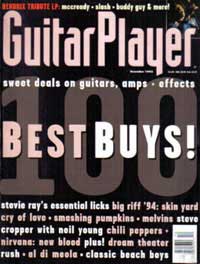Alex Lifeson: Rush Strips Down
By Andy Widders-Ellis, Guitar Player, December 1993

"We wanted to be that energetic three-piece band we were in the past," says Alex Lifeson, explaining the harder, leaner sound of Rush's Counterparts. "We decide to strip down our approach and bring up my guitar."
Lifeson plays a dominant role throughout, cutting loose with charging riffs and tough tones that harken back to the band's influential Moving Pictures. "For the first time in 12 years," he divulges, "I recorded the guitars in the studio instead of the control room. I had two amps blaring at me. It took a couple f days to get used to it, but after that, man, I loved it. I could feel the wood vibrating against my body and hear the amps coming through the pickups. I got caught up in the whole energy of the sound and the room. I thought, "Where have I been, missing all this?"."
Such a white-knuckle approach, Alex acknowledges, requires sacrifice: "Your headphones are thumping away - you know it's killing your ears- and communicating with the engineer is slower. But you feel so connected to the music. I wouldn't trade it for anything; I'm surprised I didn't clue in on this sooner."
While Rush revived classic studio techniques for Counterparts, they felt no need to alter their pre-production scheme. As they have for years, the band developed sophisticated song demos before setting foot in the land of 2" tape. Alex and bassist Geddy Lee used Alesis ADAT 8-track digital recorders to audition ideas and refine parts. Later they transfer red those tapes to the studio's multitrack, and the home recordings became guide tracks. One by one, the trio overdub bed their respective parts, replacing the originals. Lifeson printed his guitars to analog tape; everything else was captured digitally.
On several songs, including the punchy "Cut To The Chase", Lifeson's bandmates encouraged him to keep the original guide solos. "Solos are a funny thing," Alex observes, "Many solos I record at the demo stage make it to the final mix. I tend to be a perfectionist, but I've come to realize my best work is spontaneous. An unrehearsed solo may not be particularly in time or in tune, but it can possess an emotional quality that's very difficult to recapture. At this point, I'd rather live with some technical imperfections."
Lifeson cut his ADAT parts by sending a direct line from his Gallien-Krueger amp to a Palmer speaker simulator and then to the mixer. He added effects while tracking. In the studio, however, Alex pounded his riffs through two heads - a Peavey 5150 and a 100-watt Marshall- with 4x12 cabinets. "For all the bed tracks, I plugged straight into the amps, with no effects, and cranked it up."
Unlike players who hire a cartage service to haul dozens of guitars to a session, Alex says he relied on a few familiar friends for Counterparts. "I mostly played my Paul Reed Smith, Les Paul, and Tele. I played the Paul a lot - it's prominent on "Stick It Out", for example. Quite often I combined the Tele with the Paul to create a single sound. Lifeson also likes to layer acoustic guitars: "I have a big, sort of metallic sounding Washburn and a Gibson Dove that's soft and delicate. The two together made a very complete sound. I also used a Nashville-tuned Gibson J-55, which we mixed in and out." (For this "high-strung" Nashville tuning, Alex replaced the lowest four strings with lighter gauges and tuned them up an octave.)
It's no surprise that Counterparts acoustic guitars recall Tommy-era Who tracks. "Pete Townshend can make an acoustic sound so heavy and powerful," affirms Alex. "I've always admired that. On "Between Sun And Moon" there's a musical bridge before the solo that's very Who-ish. I even throw Keith Richards in there." Lyrically and musically, Lifeson notes, the song is "really a tribute to the '60s." Yet these days, he find himself listening to contemporary players. "Particularly Pearl Jam and Alice in Chains - I've been really getting off on Dirt. And I love Eric Johnson's playing."
Soon, Lifeson plans to return to basics with his stage setup. "For the next tour, I want te revamp my whole line. I'm planning on using Marshalls again, after a 15 years hiatus. I'll be playing my PRS guitars; I might even break out the Les Paul for one or two songs." In the '80s, the Canadian favored single-coils. "To be quite honest," he reveals, "I've moved away from that sound; I much prefer the warmth of humbuckers."
Creativity, concedes Alex, runs in cycles. "After we finish a record, I put my guitar down and don't play for months. When I pick it up again, I really stink. It takes me a while to get back into shape, but in the process, I start playing things I never would have thought of before. I discover different styles." Exploring the fretboard in solitude is rejuvenating, says Lifeson: "My greatest enjoyment is sitting alone in my home studio, playing through my amp with a really great sound. Not working on a song, just playing. I get completely lost and the hours fly by. I still do it, after all these years."